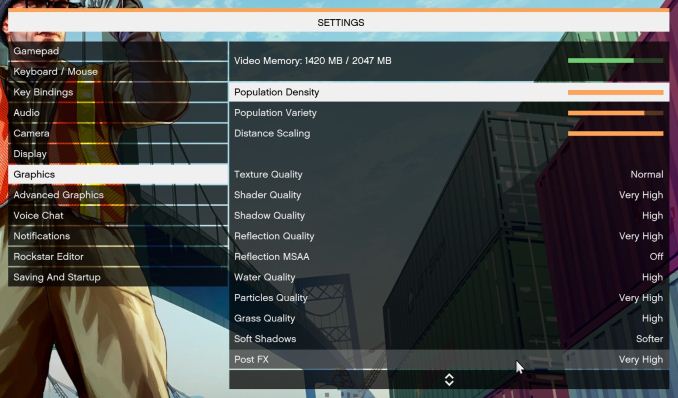The AMD 2nd Gen Ryzen Deep Dive: The 2700X, 2700, 2600X, and 2600 Tested
by Ian Cutress on April 19, 2018 9:00 AM ESTGrand Theft Auto
The highly anticipated iteration of the Grand Theft Auto franchise hit the shelves on April 14th 2015, with both AMD and NVIDIA in tow to help optimize the title. GTA doesn’t provide graphical presets, but opens up the options to users and extends the boundaries by pushing even the hardest systems to the limit using Rockstar’s Advanced Game Engine under DirectX 11. Whether the user is flying high in the mountains with long draw distances or dealing with assorted trash in the city, when cranked up to maximum it creates stunning visuals but hard work for both the CPU and the GPU.
For our test we have scripted a version of the in-game benchmark. The in-game benchmark consists of five scenarios: four short panning shots with varying lighting and weather effects, and a fifth action sequence that lasts around 90 seconds. We use only the final part of the benchmark, which combines a flight scene in a jet followed by an inner city drive-by through several intersections followed by ramming a tanker that explodes, causing other cars to explode as well. This is a mix of distance rendering followed by a detailed near-rendering action sequence, and the title thankfully spits out frame time data.
There are no presets for the graphics options on GTA, allowing the user to adjust options such as population density and distance scaling on sliders, but others such as texture/shadow/shader/water quality from Low to Very High. Other options include MSAA, soft shadows, post effects, shadow resolution and extended draw distance options. There is a handy option at the top which shows how much video memory the options are expected to consume, with obvious repercussions if a user requests more video memory than is present on the card (although there’s no obvious indication if you have a low end GPU with lots of GPU memory, like an R7 240 4GB).
To that end, we run the benchmark at 1920x1080 using an average of Very High on the settings, and also at 4K using High on most of them. We take the average results of four runs, reporting frame rate averages, 99th percentiles, and our time under analysis.
All of our benchmark results can also be found in our benchmark engine, Bench.
MSI GTX 1080 Gaming 8G Performance
1080p



4K
















545 Comments
View All Comments
Santoval - Thursday, April 19, 2018 - link
It's possible that the first consumer Intel 8-core will be based on Ice Lake. Cannon Lake will probably largely limited to low power CPUs, and will probably top out at 4 cores. Of course if Ice Lake is delayed again Intel might scale out Cannon Lake to more cores. Cannon Lake will be just a 10nm node of the Skylake/Kaby/Coffee Lake architecture, so it will most likely provide mostly power efficiency gains.aliquis - Thursday, April 19, 2018 - link
Latest road map show coffee lake refresh in Q4.mahoney87 - Thursday, April 19, 2018 - link
lol :Dhttps://imgur.com/SmJBKkf
They done fecked up
Luckz - Monday, April 23, 2018 - link
Rocket League is a joke game when it comes to benchmarking, optimization and so on.Chris113q - Thursday, April 19, 2018 - link
Do you really need to be spoon-fed information? How long would it take you to find the other reviews by yourself?PCPER, Tweaktown, Toms Hardware, Hothardware, Computerbase all had different results (can't post link due to spam protection). Not to mention you'd have to be totally tech illiterate to believe that stock 2600 can beat 8700k by such a huge margin. Meltdown/Spectre patches don't affect gaming performance that much, so don't you put blame on that.
The result discrepancy is embarrassing, there goes the last speck of reputation Anandtech had as a reliable source of tech news.
MuhOo - Thursday, April 19, 2018 - link
You sir are right.Aegan23 - Thursday, April 19, 2018 - link
You do know who Ian is, right? XDsor - Thursday, April 19, 2018 - link
Anandtech has no responsibility to go out and ensure their results match up with anyone else’s. They run their own selection of tests with their own build and report the numbers. They provide the test setup, if you can’t spot the differences that’s your own issue.Ryan Smith - Thursday, April 19, 2018 - link
"Anandtech has no responsibility to go out and ensure their results match up with anyone else’s"Responsibility? No. But should we anyhow? Yes.
Our responsibility is accuracy. If something looks weird with our data - which it does right now - then it's our job to go back, validate, and explain the results that we're seeing. If our results disagree with other sites, then that is definitely an indication that we may have a data issue.
xidex2 - Thursday, April 19, 2018 - link
I bet none of the other sites applied spectre and meltdown patches for Intel because they dont care about such things. Intel fanboys are now crying because someone actually showed true numbers.